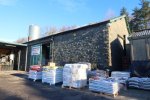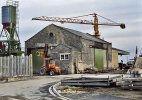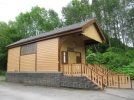How likely do you think a railway goods shed could survive for fourteen years?
I've covered most of my old branch line's details (and probably bored a lot of people in the process!) but there is still one mystery that's puzzled me for a long time now - the demolition date of Padiham's goods yard shed.
Despite the station itself at Padiham being demolished August 1967, the goods yard didn't close until June 1968. The shed itself was unusual in the fact it was a large wooden structure. It had two road loading bays and two internal cranes.
One photo dated August 1982 shows a large factory covering the former goods yard and part of the former station, however I've found out this factory was a large snooker factory and was officially opened by the then minister of sport June 1984. The factory was 100,000 sq ft in size. The 1984 date of opening I know to be correct.
Presuming (something I hate doing) that this factory took "some time" to build, possibly starting in 1983 that gives me a gap (give or take a few months) of 14 years from goods yard closure to factory build.
Questions please:
How likely do you think it is that the goods shed actually survived for 14 years?
Is it possible that some of the coal merchants might have continued to operate from the closed goods yard? I know this happened at Simonstone just 1 mile away.
I've covered most of my old branch line's details (and probably bored a lot of people in the process!) but there is still one mystery that's puzzled me for a long time now - the demolition date of Padiham's goods yard shed.
Despite the station itself at Padiham being demolished August 1967, the goods yard didn't close until June 1968. The shed itself was unusual in the fact it was a large wooden structure. It had two road loading bays and two internal cranes.
One photo dated August 1982 shows a large factory covering the former goods yard and part of the former station, however I've found out this factory was a large snooker factory and was officially opened by the then minister of sport June 1984. The factory was 100,000 sq ft in size. The 1984 date of opening I know to be correct.
Presuming (something I hate doing) that this factory took "some time" to build, possibly starting in 1983 that gives me a gap (give or take a few months) of 14 years from goods yard closure to factory build.
Questions please:
How likely do you think it is that the goods shed actually survived for 14 years?
Is it possible that some of the coal merchants might have continued to operate from the closed goods yard? I know this happened at Simonstone just 1 mile away.




